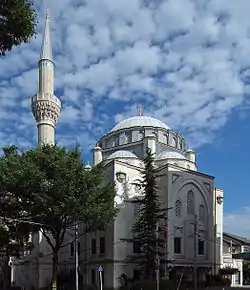| Tokyo Mosque | |
|---|---|
東京ジャーミイ | |
 | |
| Religion | |
| Affiliation | Sunni Islam |
| Leadership | İmam Hatibi Muhammet Rıfat Çınar |
| Location | |
| Location | Shibuya, Tokyo, Japan |
 Shown within Special wards of Tokyo | |
| Geographic coordinates | 35°40′05″N 139°40′35″E / 35.66806°N 139.67639°E |
| Architecture | |
| Architect(s) | Muharrem Hilmi Senalp |
| Type | Mosque |
| Date established | 30 June 2000 |
| Groundbreaking | 1998 |
| Completed | 2000 |
| Construction cost | 1.5 billion yen |
| Specifications | |
| Dome(s) | 1 |
| Minaret(s) | 1 |
| Minaret height | 41.48 meters |

Tokyo Mosque, Tōkyō-jāmii (東京ジャーミイ) also known as Tokyo Camii (pronounced Jamii in Arabic), is a mosque with an adjoining Turkish culture center located in the Ōyama-chō district of Shibuya ward in Tokyo, Japan. It is the largest mosque in Japan.
Originally built in 1938, the current building was completed in 2000. It was designed by Hilmi Şenalp, in a style inspired by Ottoman architecture.
History
The mosque was originally built along with an adjoining school on May 12, 1938 by Bashkir and Tatar immigrants from Russia who had come to Japan after the October Revolution. It was made under the direction of Abdurreshid Ibrahim, the first Imam of the mosque, and Abdülhay Kurban Ali.
In 1986, the mosque had to be demolished because of severe structural damage. Under the direction and support of Turkey’s Directorate of Religious Affairs, a new building was begun in 1998. The architect for the building was Hilmi Şenalp. The ornamentation was based on Ottoman religious architecture. Around 70 Turkish craftsmen performed the finishing details, and a considerable quantity of marble was imported from Turkey. The construction was completed in 2000 at a cost of around 1.5 billion yen. The inauguration was held on June 30, 2000.[1]
Description
Tokyo Mosque is 734 square meters in area and has one basement floor and three above-ground floors with a total floor area of 1,477 square meters. Its main dome is 23.25 meters tall and is supported by six pillars, while the adjacent minaret is 41.48 meters tall.[2]
Each floor of the building houses a different activity for worshipers at that mosque. The first floor is a common area, the second floor is the prayer room, housing the mihrab, and a minbar, elevated steps for the imam to deliver the sermon.[3]
Color Depicted In Ottoman Mosques
All throughout the interior and exterior of the Tokyo Mosque the colors white, and turquoise are heavily used. Since this mosque is modeled after Ottoman architecture the colors that are utilized are reflected throughout this structure and the use of the colors implemented are reciprocated as well. The color turquoise is a color that is regarded to be a representation of holiness, a color depicted as early as ancient Iran.[4] The minbar and mihrab are both covered in white marble, a color that most known to represent purity in relation to God and pure light,[5] while the gold detailing on both of the functional ornaments allows the pieces to further stand out in the mosque.
This structure also heavily resembles another mosque created under the same Ottoman architecture style, the Blue Mosque.[6] Color within these mosques are highlighted through their use of natural and artificial lighting, natural via the many windows that encompass the mosque and artificial via the low hanging chandeliers.[5] The connection between the use of light and color to an audience is known and utilized throughout the creation of mosques, as the architects try and incorporate enough of each to create an impact on the viewer of the building.[4]
Gallery
 Interior looking towards the minbar
Interior looking towards the minbar Interior showcasing the mihrab
Interior showcasing the mihrab Arabic calligraphy shown on the pendentives.
Arabic calligraphy shown on the pendentives. Details on the Tokyo Mosque dome
Details on the Tokyo Mosque dome Minaret located outside of the Tokyo Mosque
Minaret located outside of the Tokyo Mosque
See also
References
- ↑ “New Tokyo Mosque opens”, in: The Japan Times, July 1st, 2000.
- ↑ “Japan's largest mosque completed in Tokyo”, in: Kajima News & Notes, Autumn 2000.
- ↑ "Tokyo Camii Mosque Japan المسجد التٌركي-طوكيو | Japan Halal TV". Japan Halal TV(ジャパンハラールTV)|ハラール特化型インターネットテレビ局. Retrieved 2021-12-07.
- 1 2 Mahdi Nejad, J; Zarghami, E; Sadeghi Habib Abad, A (2018-03-14). "A study on the concepts and themes of color and light in the exquisite islamic architecture". Journal of Fundamental and Applied Sciences. 8 (3): 1077. doi:10.4314/jfas.v8i3.23. ISSN 1112-9867.
- 1 2 Namiri, Mahsa Esmaeili; Sani, Rafooneh Mokhtarshahi (2017). "Symbolic Meaning of Colours in Safavid and Ottoman Mosques". Journal of Shi'a Islamic Studies. 10 (1): 91–123. doi:10.1353/isl.2017.0003. ISSN 2051-557X.
- ↑ Kantar, Billur Mine. "The Blue Interpretation of Art: The Blue Mosque".
External links
- Official Website - English, Japanese and Turkish.
- Information about the building - Japanese
